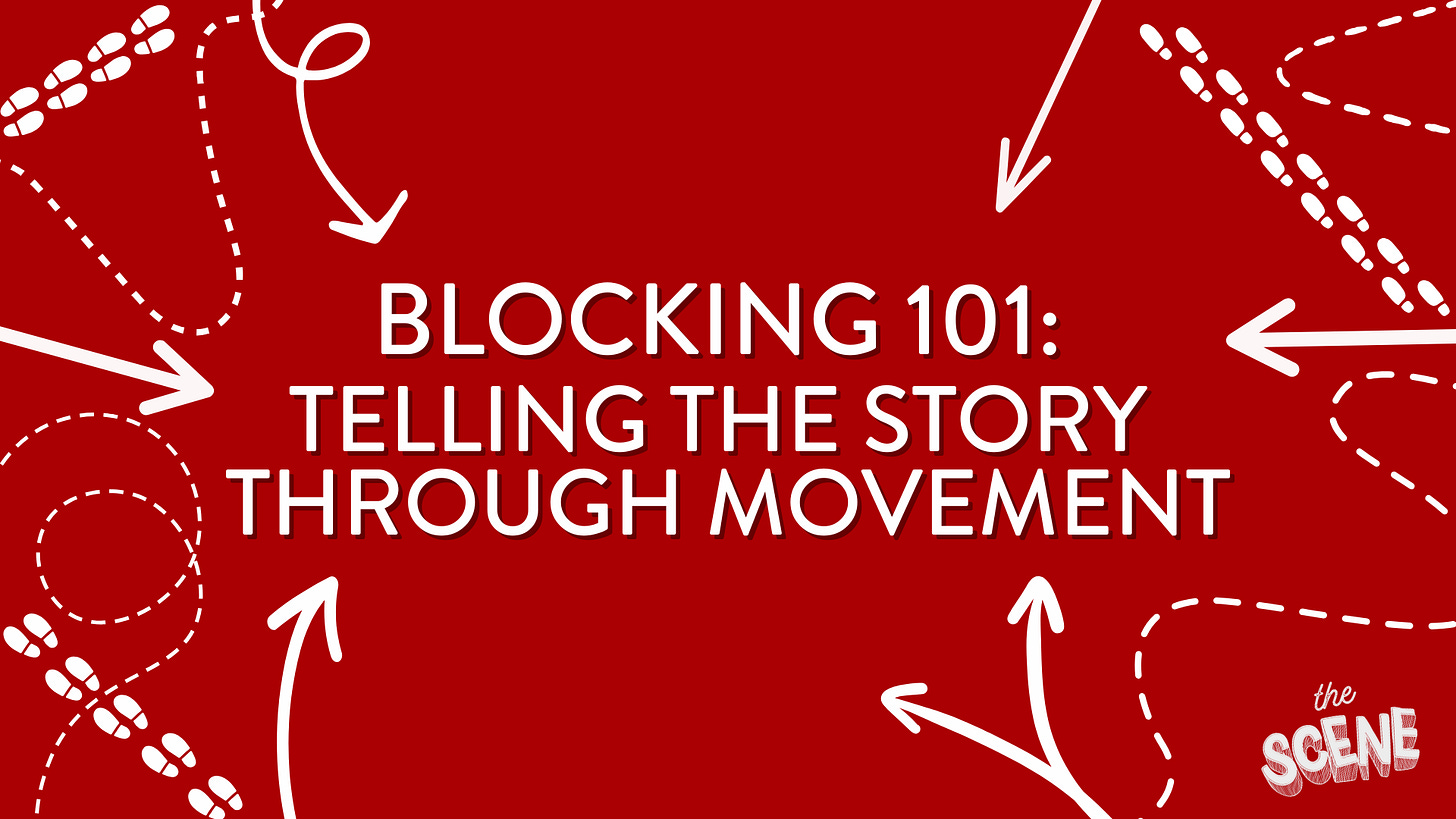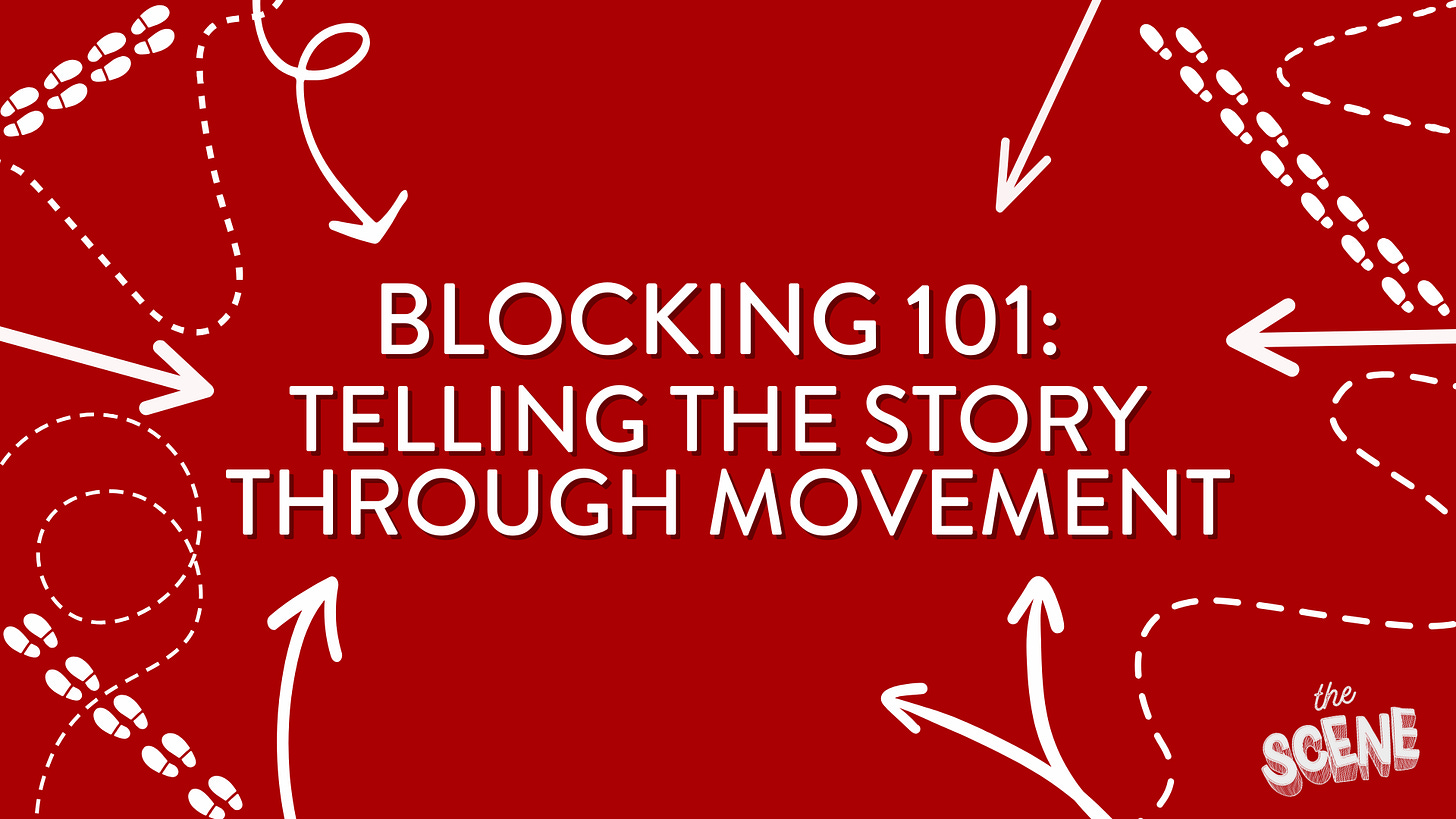Blocking 101: Telling the Story Through Movement
Plus, your weekly round-up of theatre news you may have missed!
Welcome to The Scene, your weekly round-up of theatre news you may have missed.
In this week's edition,
We discuss how to make blocking more than traffic control by keeping it simple, story-driven, and collaborative. Discover practical classroom exercises that help students unlock character intention and remember their blocking with confidence.
Finally, don’t miss this week’s free read from Playscripts: Aesop Live! by Tracy Wells.
So, raise the curtain and shine the spotlight as we dive into another thrilling week in the theatre world. Welcome to The Scene.
The Broadway Musical Is in Trouble by Michael Paulson, The New York Times | With the cost of staging song-and-dance spectacles skyrocketing and audiences drawn to older hits, none of the musicals that opened last season have made a profit. Fewer are planned this season. Read...
Cheyenne Jackson, John-Andrew Morrison Will Star Opposite Jane Krakowski in Oh, Mary! by Logan Culwell-Block, Playbill | The Cole Escola comedy continues its run at the Lyceum Theatre. Read...
Nicholas Braun and Kara Young Will Star in Gruesome Playground Injuries Off-Broadway by Meg Masseron, Playbill | The new production of Pulitzer Prize finalist Rajiv Joseph’s play will come to the Lucille Lortel Theatre this season. Read...
See Jonathan Groff Perform ‘Mack The Knife’ on The Tonight Show with Jimmy Fallon by Margaret Hall, Playbill | Groff stopped by the late night show to showcase his Tony nominated performance as Bobby Darin. Read...
Louisville Will Be New Home for International Thespian Festival Beginning in 2027 by Andrew Gans, Playbill | Educational Theatre Association presents the annual gathering of middle and high school students. Read...
Thanks to Robert Redford, Sundance Was Also a Theatre Incubator by Philip Himberg, American Theatre | Though he personally left behind stage work early in his career, through his Sundance Institute Redford championed and empowered generations of theatremakers in the U.S. and the world. Read...
‘Mexodus’ Tells an Underground Railroad Story You’ve Probably Never Heard by Sopan Deb, The New York Times | In this new hip-hop musical from Nygel D. Robinson and Brian Quijada, audiences hear a tale of reverse migration: Slaves leaving the United States for Mexico. Read...
Filmed National Theatre Productions Coming to U.S. Schools via Educational Theatre Association by Logan Culwell-Block, Playbill | The partnership will bring free and unlimited access to more than 70 filmed shows to educators. Read...
The Big Idea
Blocking 101: Telling the Story Through Movement
by Zach Dulli, The Scene
The curtain hasn’t risen yet, but the story is already being told. A student takes a step forward. Another leans back. A character folds their arms or drops their gaze. These are not accidents. They are choices. Blocking is not about traffic control. It’s about truth. The audience reads the story through bodies in motion just as much as they do through lines in the script.
For too many directors, blocking feels like a chore. For too many students, it feels like following directions on a road map they didn’t choose. But when it’s done right, blocking is not a list of stage positions. It’s choreography for the soul of your play. The good news is you don’t need to reinvent ballet to get it right. What you need is clarity, collaboration and a little creativity.
Start With the Story
Blocking is storytelling in three dimensions. Before moving a single chair, ask yourself: What does each character want in this moment? How far are they willing to go to get it? Where does the power shift? A cross downstage can appear to be either an attack or a plea. A pause center stage can feel like victory or isolation.
Help your students connect the dots. “When you take that step away, it’s not about distance. It’s about rejection.” Suddenly, movement is not arbitrary. It’s emotional math. It’s cause and effect. And once they understand that, the blocking makes sense.
Keep It Simple
Simplicity doesn’t mean boring. It means clear. A single step can speak louder than a dozen circles. Give your students movements that are purposeful. Anchor them to emotion and text. “On the word ‘enough,’ you turn.” “When she laughs, you sit.” Clarity builds confidence. Students aren’t memorizing patterns, they’re playing intentions.
Collaboration Over Dictation
Your students want ownership. Invite them into the process. Ask, “Where do you feel your character would go?” Sometimes they’ll surprise you. Sometimes their instincts will unlock the scene in ways you hadn’t considered.
That doesn’t mean you surrender the director’s chair. You refine, you shape, and then you step back to look at the picture as a whole. However, when students are co-authors of the movement, they become invested in the story. They don’t just remember blocking. They remember why it mattered.
Exercises to Unlock Storytelling Through Movement
Here are a few rehearsal exercises that make blocking less about traffic control and more about discovery:
Emotional Crosses – Line up your cast on one side of the stage. Give them a single line from the script. Their task is to cross the stage, but the way they do so must reflect their emotions. Do they storm? Do they tiptoe? Do they hesitate in the middle? Suddenly, a cross is not “go left to right.” It’s “show us how you feel without words.”
Freeze and Shift – Run a scene and call “freeze” at a key moment. Ask students to describe what the picture conveys to the audience. Then ask one actor to shift their body slightly – a turn of the shoulder, a step forward. Freeze again. Did the story change? Students begin to see how even minor adjustments can alter meaning.
Power Lines – Have two actors stand at opposite ends of the stage. Their job is to use movement to show who has more power in the scene. They can step forward, step back, or change levels. At the end, ask the rest of the cast: Who had control? This game sharpens instincts about space, status and storytelling.
Silent Scene – Take a scene and strip away the dialogue. Let the actors run it with movement only. No words. Just gestures, crosses, levels and eye contact. Afterwards, ask the audience what they understood. You’ll be surprised how much story comes through without a single line spoken.
Make It Memorable – High school students have enough to memorize. Blocking sticks when they connect to intention. If they know why they move, they won’t forget where to move. Pair blocking with keywords, emotions or beats. Turn it into music: the rhythm of speech and the rhythm of steps should complement each other. Memory follows meaning.
The Final Word
Blocking is not telling students where to stand. It’s showing them how to tell the truth of the play with their bodies. When you frame it this way, you turn rehearsal from a game of “Simon Says” into a lab for human behavior. Students learn to inhabit space with purpose. They discover how to tell stories with silence, stillness and movement.
And that’s what theatre is. Not static. Not staged. Alive. The curtain rises, and with every step, every turn, every moment of stillness, the story breathes.
So don’t block the play. Unlock it.
13 Going on 30 The Musical Begins Performances by Margaret Hall, Playbill | The stage adaptation has been in the works since at least 2016. Read...
Beetlejuice to open in the West End (finally) by Alex Wood & Tanyel Gumushan, WhatsOnStage | We said its name slightly more than three times – and now it’s arrived! Read...
British Theater, Up Close on the Big Screen by Valeriya Safronova, The New York Times | NT Live, an arm of Britain’s National Theater, is reaching huge audiences around the world who can’t make it to London to see its performances. Read...
Birmingham Rep announces new 2026 to 2027 season including Sweeney Todd and The Curious Incident of the Dog in the Night-Time revivals by Tanyel Gumushan, WhatsOnStage | Sondheim’s Sweeney Todd! Raving Shakespeare! And much more! Read...
Maine theater with history of legendary Broadway stars premieres new musical about Elvis, the Beatles by David Wade, CBS News | The world-premiere musical “When Elvis Met the Beatles“ is portraying legends on stage at the Ogunquit Playhouse in Maine. Read...
Aaron James McKenzie to Star in New Musical by Tom Morello, Revolution(s) by Margaret Hall, Playbill | The new musical from the Rage Against the Machine and Audioslave musician follows a soldier and aspiring musician who return home from Afghanistan to discover the South Side of Chicago is now occupied territory. Read...
Andrew Scott’s Vanya Understudy Marianna Gailus Will Be Hedda Gabler at Yale Repertory by Andrew Gans, Playbill | James Bundy will direct Paul Walsh’s adaptation of the Henrik Ibsen classic. Read...
What Do the Reviews Say About Damn Yankees at Arena Stage? by Margaret Hall, Playbill | The Washington D.C. production is newly revised by Will Power, Doug Wright, and Lynn Ahrens. Read...
Free Reads of the Week
Read entire plays for free! Playscripts offers a selection of full-length and one-act plays that you can access for free, which is ideal for use in theatre productions, school performances, or competitions. To explore these titles, click on the cover image below or select the "READ FOR FREE" button at the bottom of this section. This action will direct you to the play's page on the Playscripts website. Once there, click "READ NOW" to begin enjoying the play immediately!
Aesop Live! by Tracy Wells
The Story: Aesop’s wonderfully colorful fables burst onto the stage in Aesop Live! Two narrators threaten to retell all seven hundred and twenty-five ancient Greek tales in just one show, morals included. But never fear! The cleverly told and entertaining stories they present are packed with fan-favorite characters like the sneaky Wolf, the clever Crow, the sly Fox, and of course, the Tortoise and the Hare. A brisk, action-packed show, Aesop Live! is the most fun you can have while learning the dos and don’ts of ethical living. (A full-length and one-act version of this play is available.)
Genre: Comedy | Run-Time: 70-80 minutes | Casting: 5 W, 5 M, 75 Any (5-75 actors possible: 5-75 W, 5-75 M) | Set: Flexible











